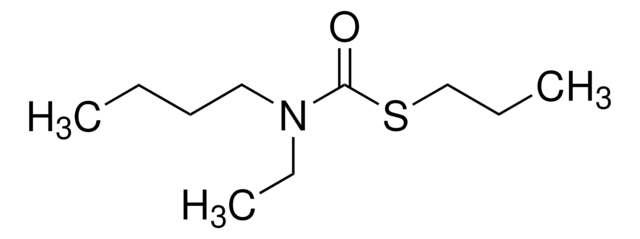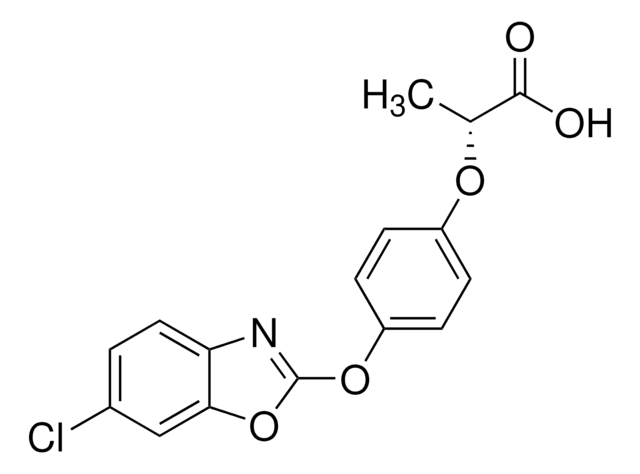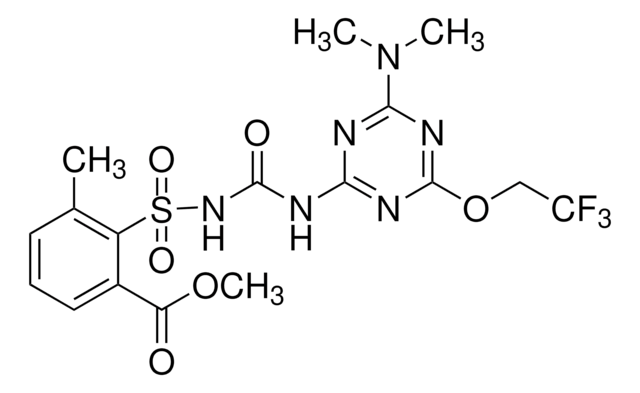CRM69034
Cycloate
certified reference material, TraceCERT®, Manufactured by: Sigma-Aldrich Production GmbH, Switzerland
Synonyme(s) :
S-Ethyl N-cyclohexyl-N-ethylthiocarbamate
About This Item
Produits recommandés
Qualité
certified reference material
TraceCERT®
Niveau de qualité
Gamme de produits
TraceCERT®
Durée de conservation
limited shelf life, expiry date on the label
Fabricant/nom de marque
Manufactured by: Sigma-Aldrich Production GmbH, Switzerland
Format
neat
Chaîne SMILES
CCSC(=O)N(CC)C1CCCCC1
InChI
1S/C11H21NOS/c1-3-12(11(13)14-4-2)10-8-6-5-7-9-10/h10H,3-9H2,1-2H3
Clé InChI
DFCAFRGABIXSDS-UHFFFAOYSA-N
Vous recherchez des produits similaires ? Visite Guide de comparaison des produits
Catégories apparentées
Description générale
Certified content by quantitative NMR incl. uncertainty and expiry date are given on the certificate.
Download your certificate at: http://www.sigma-aldrich.com
Cycloate-a thiocarbamate herbicide and a lipid biosynthesis inhibitor, finds its use in the control of annual grass weeds, perennial grasses, and annual broad-leaved weeds in spinach, sugar beet, fodder beet, and
beetroot.
Cycloate is not approved for its use in the European Union (EU) as a plant protection agent. This is in accordance with Regulation (EC) No 1107/2009 of the European Parliament and repealing the Council Directives 79/117/EEC and 91/414/EEC. But a default maximum residue limit (MRL) of 0.01 mg/kg has been set as per Art 18(1)(b) Reg 396/2005.
Application
The cycloate CRM may also find given below uses:
- Solid phase extraction (SPE) followed by gas chromatography-mass spectrometry (GC-MS) analysis of 88 pesticide residues in strawberry, raspberry, blueberry, and grape samples
- Multi-residue determination of 118 pesticide residues in tea samples by solid phase extraction (SPE) and gas chromatography-mass spectrometry (GC-MS)
- Multi-class analysis of 21 pesticides in Chios mastic gum by QuEChERS for sample treatment, UHPLC for separation, and electrospray triple quadrupole mass spectrometry (ESI-MS/MS) for quantification
- Development and validation of a multi-residue method for the detection and quantification of 109 pesticides in tomato samples by modified QuEChERS based sample clean-up, followed by liquid chromatography-tandem mass spectrometry (LC-MS/MS)
- Evaluation of a method for multi-class analysis of 170 pesticide residues in soya nutraceutical capsule samples by QuEChERS based extraction and GC-MS/MS quantitation
- Detection and measurement of 115 pesticide residues in 400 commercial orange samples by high-performance liquid chromatography-triple-quadrupole mass spectrometry (LC-MS/MS) coupled with modified QuEChERS based sample treatment
Informations légales
Mention d'avertissement
Danger
Mentions de danger
Conseils de prudence
Classification des risques
Acute Tox. 3 Inhalation - Aquatic Chronic 2
Code de la classe de stockage
6.1C - Combustible acute toxic Cat.3 / toxic compounds or compounds which causing chronic effects
Classe de danger pour l'eau (WGK)
WGK 2
Point d'éclair (°F)
271.4 °F
Point d'éclair (°C)
133 °C
Choose from one of the most recent versions:
Certificats d'analyse (COA)
Don't see the Right Version?
If you require a particular version, you can look up a specific certificate by the Lot or Batch number.
Déjà en possession de ce produit ?
Retrouvez la documentation relative aux produits que vous avez récemment achetés dans la Bibliothèque de documents.
Notre équipe de scientifiques dispose d'une expérience dans tous les secteurs de la recherche, notamment en sciences de la vie, science des matériaux, synthèse chimique, chromatographie, analyse et dans de nombreux autres domaines..
Contacter notre Service technique










